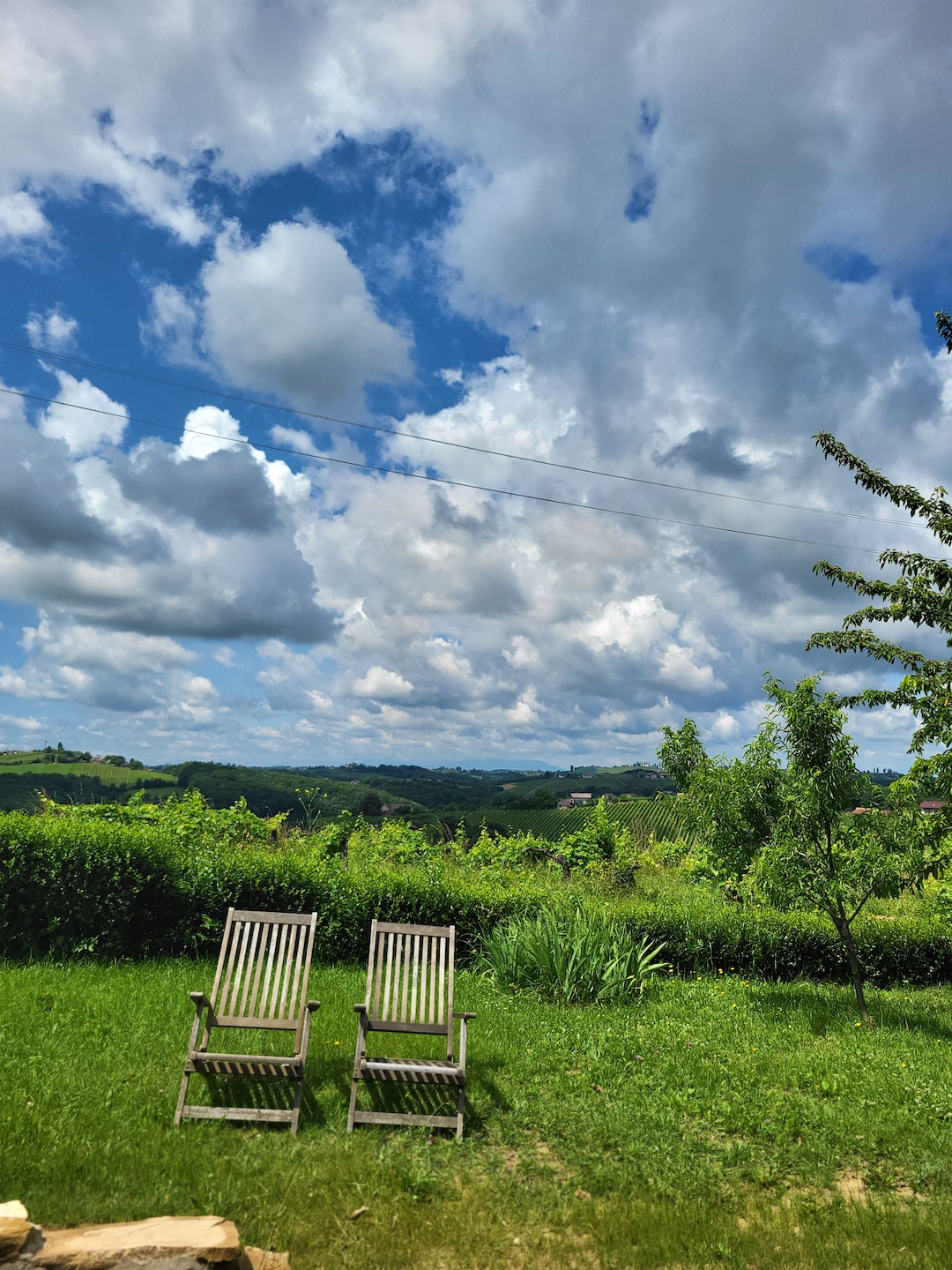At a time when more and more people are aware of the importance of sustainability and environmental protection, the way we build, renovate and live is becoming increasingly important. In renovating Hiška pod Klumpo, we followed a philosophy that is simple yet often overlooked: respect for nature, use of local materials, and preservation of tradition. It wasn't just about renovating a house - it was about creating a space that is in harmony with the environment, that reduces impact on the planet, and that simultaneously offers all the comforts of modern living.
Why Is Sustainability Important?
Buildings and construction represent approximately 40% of global carbon dioxide emissions. Every material we use, every energy we consume, has its environmental footprint. Traditional construction methods and use of conventional materials often require enormous amounts of energy and produce large quantities of waste.
But sustainability isn't just about reducing negative impact - it's also about positive effects. Buildings constructed or renovated sustainably are healthier to live in, more energy efficient (which reduces costs in the long term), and often aesthetically more beautiful, as they use natural materials and follow organic principles.

Choosing Materials: Local and Natural
One of the most important aspects of sustainable renovation is the choice of materials. Every material has its environmental footprint - from obtaining raw materials, through production and transport, to use and final disposal. Our philosophy was to use materials that are locally sourced, natural and renewable, durable and low-maintenance, and non-toxic and healthy for living.
Wood
Wood was our primary choice for numerous renovation elements. We used wood from local forests, mostly oak and spruce. Wood is an exceptional material - it's renewable (if the forest is managed sustainably), absorbs carbon dioxide while growing, is an excellent insulator, and creates a warm, natural atmosphere.
Old wooden beams were carefully cleaned, restored and reused. Where it was necessary to add new elements, we used locally produced wood from certified forests. All wood protection was done with natural oils and waxes, without using toxic chemicals.
Stone
Stone from local quarries was used for various elements - from foundations, through walls, to outdoor arrangements. Stone is an extremely durable material that practically requires no maintenance. In summer months, it absorbs heat during the day and radiates it at night, which helps with natural air conditioning of spaces.
Natural Insulation
Insulation is critical for a building's energy efficiency. Instead of conventional insulation materials (which are often made from petroleum derivatives), we used natural insulation materials like cellulose insulation made from recycled paper, hemp insulation, and locally sourced sheep's wool.
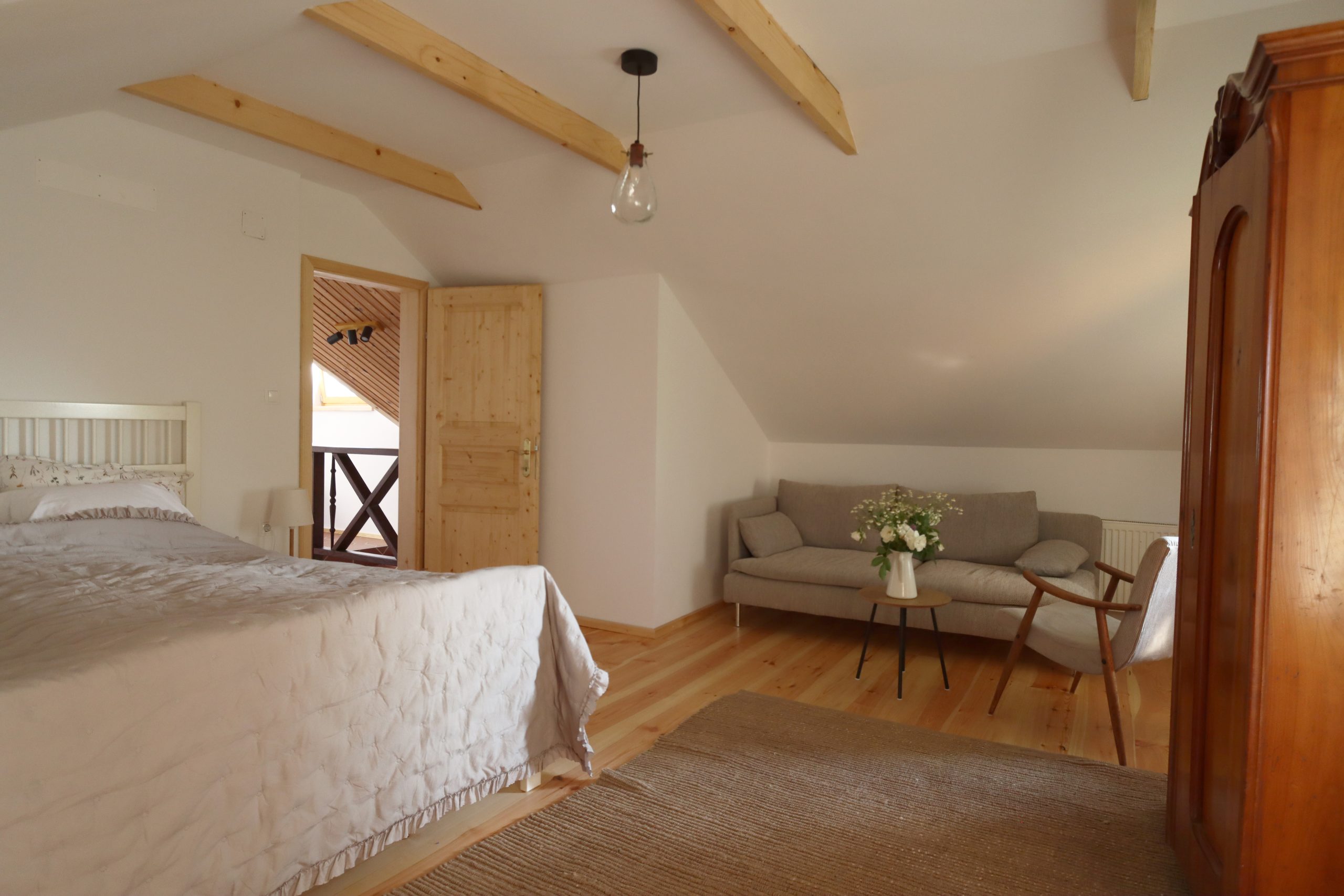
Energy Efficiency: Reducing Dependence
Sustainable living isn't just about materials - it's also about how the house functions, how much energy it consumes, where that energy comes from. Our goal was to create a house that consumes as little energy as possible and uses renewable sources.
Solar Energy
We installed solar collectors on the roof for hot water preparation. Slovenia has a surprisingly large number of sunny hours per year - even in winter months, solar collectors contribute a significant share to hot water preparation. In summer, the solar system can completely cover hot water needs, while in winter it significantly reduces the use of other energy sources.
Efficient Insulation
As mentioned, we used natural insulation materials for the entire building envelope. Thicker insulation of the roof, walls and floors dramatically reduces heating needs in winter and cooling in summer. Together with replacing old windows with new, energy-efficient windows (with triple glazing), we achieved excellent energy characteristics.
Passive Heating and Cooling
In designing the renovation, we considered principles of passive heating and cooling. Large windows on the south side allow sunlight to penetrate deep into the space and warm it in winter. Overhangs above windows prevent overheating in summer when the sun is higher in the sky.
Massive walls and stone floors act as thermal mass - they store heat during the day and slowly release it at night, creating natural temperature regulation.
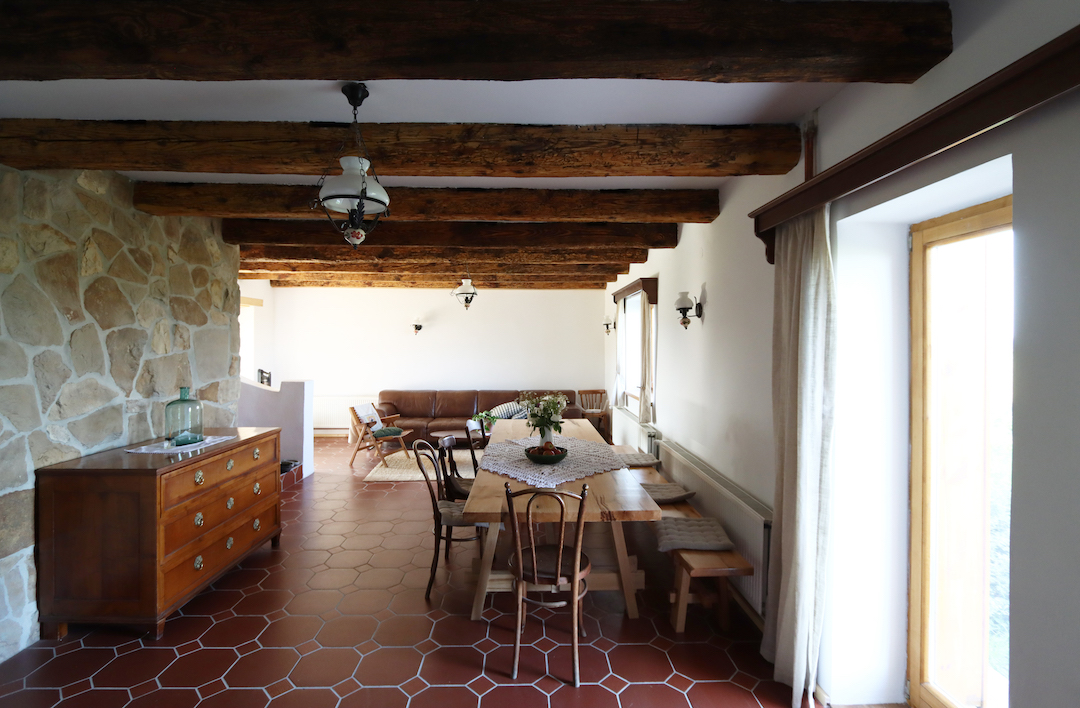
Water: Collection, Conservation, Purification
Water is a precious resource, and although Slovenia is among water-rich countries, it's important that we handle it responsibly.
Rainwater Collection
We installed a system for collecting rainwater from the roof. This water is stored in an underground reservoir and used for garden watering, filling toilet tanks, and other non-critical needs. This significantly reduces drinking water consumption for purposes where it's not needed.
Water-Efficient Fixtures
All sanitary elements are chosen with water conservation in mind - water-saving showers, faucets with aerators that reduce water flow without reducing user experience, dual-flush buttons on toilets.
Garden and Surroundings: Part of the Ecosystem
Sustainability doesn't end at the walls of the house - it extends to the entire space around it. The garden and surroundings were designed as part of the local ecosystem, not as something separate from it.
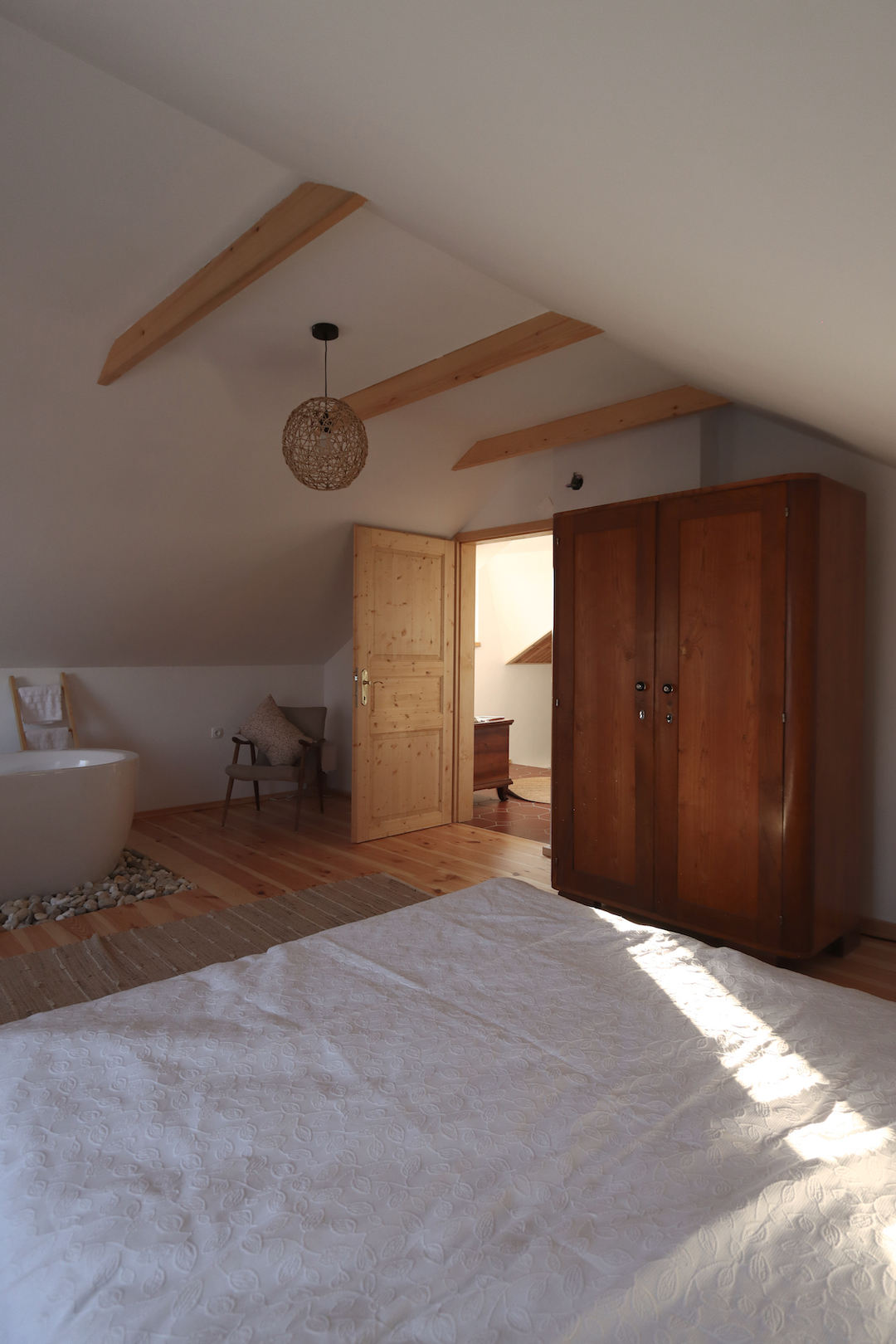
Native Plants
The garden is planted predominantly with native plants - those that naturally thrive in this region. These plants are adapted to the local climate, don't require much watering or special care, and importantly, are part of local biodiversity supported by native pollinators and other animals.
Vegetable Garden
Part of the garden is dedicated to growing vegetables and herbs. Growing your own food, even if it's just a small percentage, has multiple benefits: it reduces the need for food transport, provides the freshest possible ingredients, doesn't use pesticides or artificial fertilizers, and connects us with nature and the food growing process.
We offer guests of Hiška pod Klumpo the opportunity to pick fresh ingredients for their dinner - tomatoes, cucumbers, peppers, lettuce. Nothing is more authentic than preparing a meal with ingredients you just harvested.
Composting
All organic waste from the house is composted. The compost is then used as natural fertilizer for the garden. This circular system reduces the amount of waste and simultaneously improves soil quality.
Interior Furnishings: Quality Over Quantity
In choosing interior equipment and furniture, we followed the principle of "less is more". Instead of a multitude of cheap, quickly made objects, we chose a smaller number of quality pieces that will last.
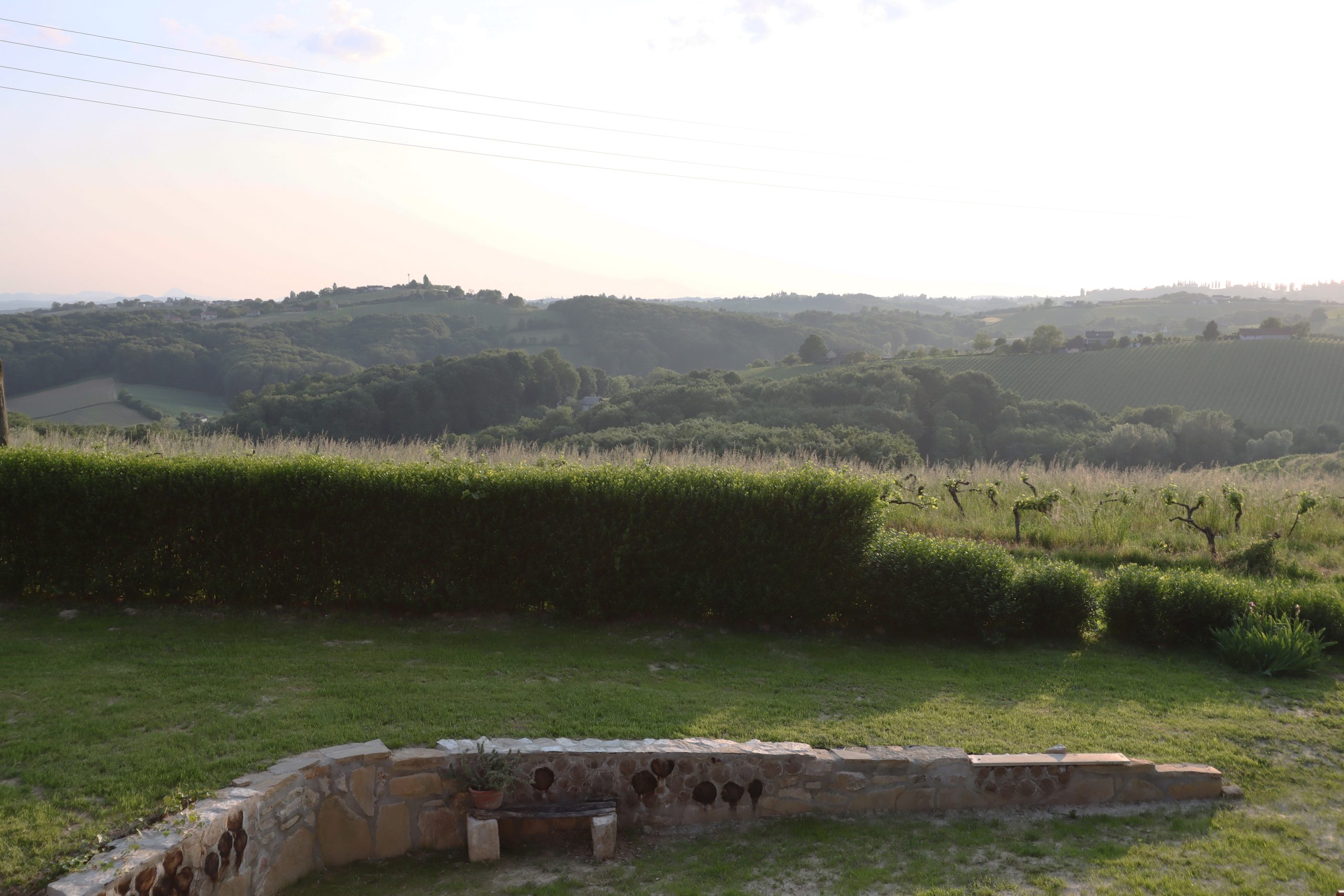
Local Craftsmen
Most of the furniture was made by a local carpentry craftsman from oak wood. Each piece is unique, handmade, with love for detail. This furniture will last decades, perhaps centuries, and can be passed on to future generations.
Vintage and Used
Some pieces of equipment we found in old attics, antique shops, or from local sellers of used items. An old wooden wardrobe, restored and reused, has a story, character - something that new, factory-made equipment will never have.
The Result: A House That Breathes
Today, when you step into Hiška pod Klumpo, you feel the difference. The air is fresh, clean. The temperature is pleasant, regardless of weather conditions outside. The light is soft, natural. Materials - wood, stone, cotton - create warmth and comfort.
But the most beautiful part isn't physical - it's the feeling. Knowing that you're staying in a space that respects nature. Knowing that every night you spend here doesn't contribute to environmental problems but is part of the solution. Knowing that you support the local community, local craftsmen, local economy.
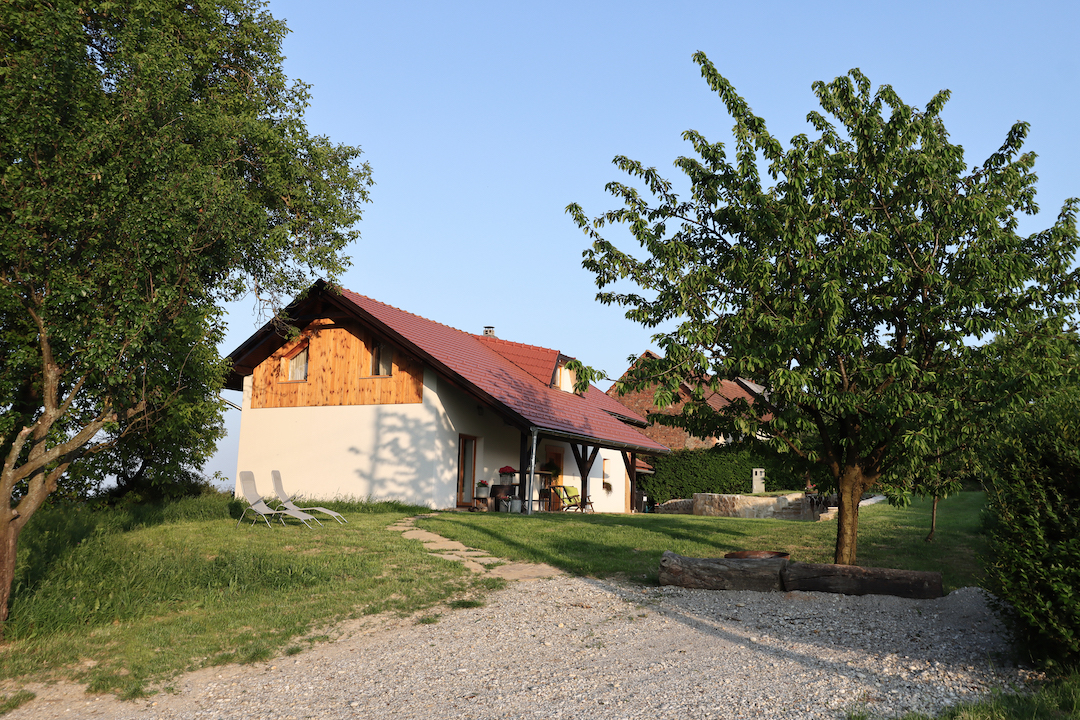
Lessons Learned and Advice
If you're considering your own sustainable renovation or construction, we'd like to share some lessons we learned:
1. Start with a clear vision: Know what you want to achieve - not just aesthetically, but also in terms of sustainability, energy efficiency, environmental impact.
2. Take your time: Sustainable renovation takes time. Don't rush. It's better to do it right than fast.
3. Involve experts: Find architects, engineers, craftsmen who understand and appreciate sustainable approaches.
4. Local is best: As much as possible, use local materials and local craftsmen. This isn't just more sustainable - you often get better quality and a story.
5. Preserve existing: Before demolishing, consider whether you can renovate. Preserving existing is often the most sustainable option.
The Impact of Sustainable Tourism
With Hiška pod Klumpo, we offer more than just accommodation - we offer an experience of sustainable living. Guests don't just come to sleep - they come to experience a different way of life, a way that is in harmony with nature.
Many guests report that staying with us inspires changes in their own lives. Perhaps they start composting. Perhaps they decide to replace windows in their house. Perhaps they simply start thinking more consciously about their choices.
This is the power of sustainable tourism - it's not just about reducing negative impact, but about creating positive impact, about education, about inspiration.
Invitation to a Sustainable Future
Hiška pod Klumpo is living proof that sustainable living is possible, accessible, and beautiful. That we can combine the comfort of modern life with respect for nature. That we can preserve tradition while simultaneously looking forward to the future.
Every visit with us is an opportunity to experience this way of life. To see, feel, and perhaps be inspired for your own sustainable projects. Because change doesn't happen overnight, doesn't happen on a global level - it happens in small steps, in individual decisions, in every house, in every garden.
Come and discover how sustainable living can become part of your life. Come and experience Hiška pod Klumpo - where tradition meets future, where comfort meets respect, where humanity meets nature.
Experience Sustainable Living
Book your escape to nature and discover how living in harmony with the environment can become part of your everyday life.
